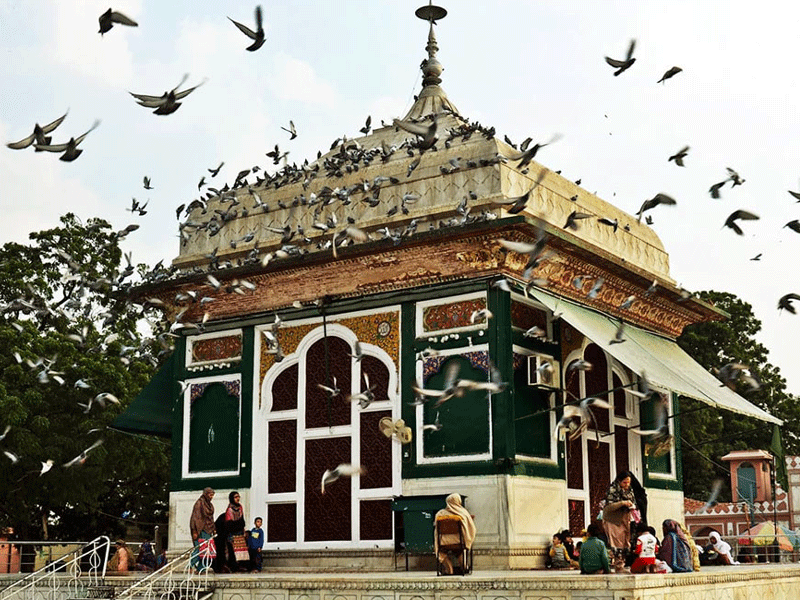Three Famous Shrines in India

- 221
- 0
AJMER SHARIF DARGAH: Visit the Tomb of Moinuddin Chishti (RA) for a Spiritual Experience!
Rajasthan, the ‘Land of Maharajas’ is home to magnificent forts and palaces all of which are depictions of Rajput valour. The religious and cultural impact that Rajasthan as a state has had on India can be compared to no other. Whenever you plan a visit to Rajasthan, you might plan a trip to the vibrant cities of Jaipur, Udaipur or Jodhpur. Make sure you also add a slot to visit the stunning city of Ajmer. The minute you hear the word Ajmer, the Ajmer Sharif Dargah is sure to pop up in your head. As the name suggests, it is a Dargah of Islamic significance, which was built in memory of Hazrat Khawaja Moinuddin Chisti (RA). It is typically a Sufi shrine which sees a hoard of devotees visiting it to experience spiritual peace. Read on to know more about the Ajmer Sharif Dargah.
About Ajmer Sharif Dargah
Ajmer Sharif Dargah is the Sufi saint Khwaja Moinuddin Chisti’s tomb. It is considered to be one of the holiest places in the world by Muslims. If you happen to visit this dargah, you are sure to feel the power through the various hymns that are sung by the Sufi saints. Interestingly, Ajmer Sharif Dargah was built during the rule of the Mughal Empire by the ruler Humayun. Khwaja Moinuddin Chisti was an extremely pious saint who had devoted himself to alleviating the poor. The idea behind him doing this was to educate the masses about the importance of selfless service. The teachings of Khwaja Moinuddin Chisti are so popular that visitors literally throng the Dargah to pay respects at his tomb.
The rich history that is associated with the Ajmer Sharif Dargah will leave you awestruck. Apart from the brilliant architecture, get ready to witness and experience spiritual peace at the tomb of Khwaja Moinuddin Chisti (RA). Khwaja Moinuddin Chisti (RA) was a Persian man who had settled in the region of Lahore which was also a part of India back then. As the story goes, the Sufi saint was believed to have locked himself up at this very place to offer prayers for the less fortunate.
Khwaja Moinuddin Chishti (RA) was almost 114 years old and his sacred mortal remains are what constitute his tomb. He breathed his last in the early 13th century and was believed to have had immense spiritual powers. Even today, you will come across stories which claim that any wish which is made in front of his tomb in Ajmer Sharif Dargah will get fulfilled.
Ajmer Sharif Dargah was built during the Mughal rule and thus depicts the typical Mughal style of architecture. You will find a number of courtyards and structures like the Jama Masjid, Buland Darwaza and Nizam Gate within the Dargah. When you enter the Dargah, you will pass through the majestic Buland Darwaza which is the grand gateway. The tomb of Khwaja Moinuddin Chisti itself, speak volumes of the magnificence of Mughal architecture. You will find the tomb under a dome-shaped chamber lined with silver railings. The surrounding pillars and walls are made out of marble which further adds an edge to the place.
Celebrations at Ajmer Sharif Dargah:
When it comes to any religious place, the abundance of festivals has to be spoken about. You will come across a large number of visitors at Ajmer Sharif Dargah even if it is not the festival season. The illuminating lights, soulful qawwali singers and a positive spiritual vibe will transport you to another world altogether. A famous celebration that you should witness at the Dargah is ‘Urs.’ It is a 6-day long festival which takes place in the 7th month as per the Islamic lunar calendar. The Buland Darwaza is kept open on all 6 days during this celebration for 24 hours. The atmosphere at Ajmer Sharif Dargah is truly a sight to see at this point of time. Get ready to immerse yourself into the Islamic culture and feel spiritually rejuvenated.
DARGAH HAZRAT
NIZAMUDDIN AULIYA (RA):
To escape from the frenetic city life, people from all walks of life to seek solace and blessing of God visit the Nizamuddin Dargah. Situated in the Delhi, Hazrat Nizamuddin (RA) is the dargah (mausoleum) of one of the world’s most famous Sufi saints, Nizamuddin Auliya (1238 - 1325 CE). Inside the dargah complex, one can find the tombs of poet Amir Khusro, Mughal princess Jehan Ara Begum, and Inayat Khan.
Dargah is sacred to the world famous Sufi saint of the Chisti Order, Nizamuddin Auliya, who was born in 1238 in Badayun, Uttar Pradesh. He traveled to Delhi to preach the Order of Chisti and then finally settled in Ghiyaspur. Nizamuddin Auliya taught people that love and peace can help them get closer to the God; also one should keep on serving people irrespective of their cast, creed, and religion. During his life, he had many followers like Hazrat Nasiruddin Mahmud Chiragh Dehlavi and Amir Khusro. On 3rd April 1325, he passed away, and his Dargah was constructed by Muhammad Bin Tughlaq of the Tughlaq Dynasty, who was also his avid follower.
A street bustling with shops selling chadars, polychrome clocks and prints of Mecca and flowers leads to the Dargah Hazrat Nizamuddin. In the inlaid marble pavilion, one can see devotees singing qawwali in the honor of celebrated Persian poet and devotee of Nizamuddin Auliya - Amir Khusrau (1253-1325). Women are not allowed to go beyond the outer verandah, but they can peek through jali ( lattice screen) to see the dark chamber where the grave of the great saint lies draped with chadar and rose petals. Locals say that tying a thread on the latticed screen serves as a constant reminder to the saint of their wishes. Apart from the main shrine, here, one can see the tomb of Nizamuddin Auliya’s saints - Jahanara Begum, Shah Jahan’s favorite daughter, and Amir Khusru.
Across the western side of the open courtyard, one can see the Jama’t Khana Mosque, which was built, was back in 1325 AD. Towards the north side of Dargah, there is a stepwell. Locals say that the stepwell was built in secret as the Tughluqabad was in making process, and all the building activities were banned. Successors of Nizamuddin Auliya made it with the help of water lit lamps. On the north-eastern side, there is a 16th-century tomb of Atgah Khan, who was a powerful minister in Emperor Akbar’s court. In the open marble pillar, Chaunsath Khamba (“64 pillars”), one can find the grave of Mirza Ghalib, preeminent Urdu, and Persian-language poet during the last years of the Mughal Empire. Other important tombs located in the NIzzamudin heritage area are the Lal-Mahal, Chini Ka Burj, Kalan-Masjid, Ataga Khan’s Tomb, Khan-I-Jahan Tilangani’s Tomb, Barapula, Chaunsath Khamba, and Khan-I-Khanan’s Tomb.
HAJI ALI DARGAH (RA):
One of the most renowned Islamic shrines, Haji Ali Dargah, is a striking illustration of the Indo-Islamic architecture style. Famous for its mesmerizing location, architectural beauty, and religious significance, the Haji Ali Dargah houses the mortal remains of a 15th-century Sufi saint, Pir Haji Ali Shah Bukhari. Situated against the backdrop of the splendid Arabian Sea, the mosque appears like an imaginary world floating on the water. One of the best places to visit near Mumbai, Haji Ali (RA) Dargah, is close to 6 km from Mumbai Chhatrapati Shivaji Terminus.
This famous Dargah in Mumbai was built by a 15th century Sufi Saint - Sayyed Pir Haji Ali Shah Bukhari. He was a rich businessman from Bukhara, which lies in present-day Uzbekistan. He decided to abandon all his materialistic wealth and worldly possessions to become a saint just before leaving for Mecca. Later, he travelled the world and finally settled in Mumbai.
A mystical history of Haji Ali (RA) Dargah is that once the Sayyed Peer came across a poor lady crying on the road while having an empty pot. The lady used to sell oil, but that day she accidentally split her oil on the road. Haji Ali went to the same spot and jabbed his fingers into the earth. The oil oozed out from the earth, and the lady refilled the vessel and thanked the saint. However, the saint had a distressing dream that night, thinking that his action had damaged the earth. He was filled with regression and sorrow that affected his health too. Later, he travelled to India and reached the Mumbai shore. He decided to live in Mumbai permanently and spread Islam awareness around the world.
Another point of historical significance is that Haji Ali (RA) Dargah is associated with the Saint’s death. It is said that he asked his followers not to bury him right away post his death rather they throw the coffin in the ocean and then bury the body in the exact place where it is found. The saint’s followers did the same, and his coffin was found on a mound in Worli. The Haji Ali Masjid and the saint’s tomb were constructed later on the same spot. Today, the tomb has become a renowned mosque where people from all religions come to seek blessings.
Published in The Daily National Courier, June, 16 2023
Like Business on Facebook, follow @DailyNCourier on Twitter to stay informed and join in the conversation.

















































